The Human Expansion Triway into Space
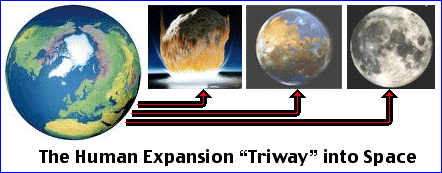
by Peter Kokh, President of the Moon Society
There are three principal human space expansion pathways advocated by persons preoccupied with one of three principal imperatives. Each of them sees space as important to the ultimate challenge facing humanity: survival of mankind.
1) Planetary Defense of our homeworld from potential impactors (Near Earth Asteroids)
2) Establishment of a viable exclave of human civilization on another world (Mars) to guarantee human survival should civilization on Earth fall victim to an impacting object, or implode through overpopulation and human-caused environmental degradation
3) Using space resources to halt and ultimately reverse environmental degradation on Earth through overuse of fossil fuels, and to make possible a more equitable global economy (The Moon)
First, let’s go into a bit more detail on each of these rationales for human expansion into space.
Then, I want to suggest why the Moon Society should, rather than concentrate solely on the third, be deeply concerned and involved in all three.
What follows is a first draft of a talk I am preparing for MarsCon 2007 in Minneapolis-St. Paul on March 3rd. My intention is to develop it into a position paper and propose it for adoption by the Moon Society Board of Directors as a guide to the Society’s future.
Let’s look at the three more closely.
1) We need to mitigate the very real threat that a large population of near Earth objects, many as yet to be detected or tracked, could in some time from today into the far future, cause significant destruction on Earth by impacts that could conceivably wipe out whole cites, devastate a continent, even cause mass extinctions on a global scale. There is no way of knowing whether one of these potential varmints might strike Earth in our lifetimes, or within the next millennium, or within the next 100,000 years. The point is, the danger is finite, and since it is conceivable that we could intervene successfully to ward off individual threats, we ought to prepare ourselves to do so. That said, it is necessary to pick or battles, choosing the most bang for the least bucks. That starts with detection, orbit tracking, and cataloging object masses and compositions. But to put the risk in perspective, weighting proximate danger more heavily, the risk of making much of Earth uninhabitable within this century by our own thoughtless habits is more real, more urgent.
Back to NEOs. Compositions are important when it comes to choosing methods of orbit correction and threat removal. Some of these objects may be solid; how they would behave in various schemes to alter their orbits will be easier to predict. Others are deeply fractured or fragmented, or even just loose aggregations of previous impact debris - literally, giant beanbags in space. Altering their orbits will be quite a challenge. Others may be dead comets, with icy snowball cores covered with dust and hydrocarbon fallback gunk deep enough to choke any further cometary outgassing.
How can the Moon fit into Planetary Defense initiatives? I propose first of all, that we attempt to identify any advantages to placing automated, teleoperated telescopes on the Moon dedicated exclusively to the detection, tracking, and classification of the near Earth object populations. In the process, we are sure to identify asteroids with resources needed for the expansion of the lunar economy, and in orbits that are relatively easy to reach. It will be in the interests of the young lunar frontier to support development of those NEO resources.
When and if a suite of possible NEO orbit modification schemes are developed, some of them may involve forward facilities on the Moon. Some of these plans may involve manned missions more economically staged from the Moon rather than from Earth.
If in modifying NEO orbits, it is feasible to shepherd some of them into stable Earth-Sun or even Earth-Moon Lagrange areas, those rich in elements in which the Moon is deficient would become less expensive sources for such elements than upshipments from Earth itself.
Thus strategic participation in a comprehensive Planetary Defense plan could have major positive implications for the viability and industrial diversification and strength of the Lunar economy. Further, it will be a long, long time, before a lunar frontier economy could survive if contact with Earth were totally interrupted. Earth is the principal market for the Lunar economy. Protecting Earth is very much in the interests of any future Lunar Settlement Frontier
Organizations concerned with Planetary Defense are:
The Planetary Society
http://www.planetary.org/programs/projects/asteroid_alert/
http://www.planetary.org/programs/projects/apophis_competition/
The Space-Frontier Foundation
http://www.space-frontier.org/Projects/Moon/PressReleases/20020712planetarydefense.html
Other links:
http://www.planetarydefense.info/
http://en.wikipedia.org/wiki/Planetary_defense
I propose that we open the door to collaboration with these organizations in the development of a thorough Planetary Defense knowledge base and systems.

2) Survival of the human race: Establishment of a self-sufficient exclave of human civilization on Mars in the event that human civilization on Earth implodes from the combined pressures of overpopulation and environmental degradation, and possible killer impacts is a priority goal shared by many. Their number should include us, not just Mars enthusiasts.
Mars does have more indigenous resources than the Moon to support a substantial frontier population. “More” is an understatement. Yet Mars’ present climate is not very attractive and it beats me how people who have made life style decisions to move to warm sunny climates can say with internal honesty that they would be willing to help pioneer a world where the temperature range is more akin to that of Antarctica. They talk the talk but can they walk the walk?
But that is neither here nor there. Mars is the best place in the Solar System on which to create an autonomous human civilization that can survive whatever may happen to Earth either by way of natural disaster or via prolonged human stupidity, very much in evidence.
Why is it in the interest of the Moon Society to support the opening of a human frontier on Mars? One word: TRADE.
The Moon lacks some of the resources needed for total self-sufficiency. This does not mean that the Moon cannot support a viable economy. Look at Japan! Japan lacked the two major wellsprings of the Industrial Revolution: coal and iron. But it had something more precious: a population that was ingenious and resourceful and determined. This island nation developed economies beyond its shores all along the western Pacific Rim in areas where resources it lacked were abundant. These areas became its core trading partners, and Japan rose to become the second greatest economy on Earth.
The Moon, hopefully with an ingenious, resourceful, enterprising population, has three other major assets that more than balance those it lacks: location, location, location. The Moon in fact is poised to become the Japan of Space. To realize that destiny, the lunar frontier must tap resources in shallower gravity wells than Earth’s: Near Earth Objects plus Mars, and Mars’ two moonlets, Phobos and Deimos. It is thus in the lunar frontier’s most vital interest to support the opening of the Martian frontier. Of course, even though “Mars only” fans are too defensive to see it, it is very much in the Martian frontier’s vital interest to see parallel development on the Moon. Earth has little need for whatever Mars can produce. The Moon will emerge as Mars’ main trading partner. The Moon in turn can trade with Earth and Earth orbiting markets.
The Moon Society can support this long range goal by prioritizing development of technologies useful on both worlds:
- modular architectures including modular biospheric systems;
- life support technologies
- space suit development
- mining, processing, and construction technologies
- small pocket hospitals
- agricultural and food production systems.
This is just the start of a potentially very long list. Of course some technologies needed on the Moon will not apply to Mars and vice versa. But considering what is to be gained by working together, that world-unique sector is trivial.
What if the Mars enthusiast community does not reply in kind? We must still support this goal. What’s in it for us trumps all essentially petty considerations. If the Mars community does not respond in kind, we still stand to gain.
Nor should we fear budgetary competition! At this stage of the game, only a consortium of governments can open Mars. Meanwhile, government outposts on the Moon serve to discourage rather than encourage commercial development there, no matter what NASA may say to the contrary. NASA culture and private enterprise culture are like oil and water, SBIRs and other gestures notwithstanding. The upshot is that the Lunar Frontier and the Martian Frontier are not competing for the same financial resources I admit that there is a pro-Moon constituency that lags behind, believing in the government pioneered route and they will be fearful of getting less than their fair share of a limited budget pie. If necessary, we have to be prepared to leave those supporters behind.
The bottom line is that to be viable long term, the Moon needs Mars as a trading partner. We should, I suggest, proclaim our support of the opening of the Mars Frontier as a goal of the Moon Society, along the lines suggested above. That does not, however, mean that we should be preoccupied with it.
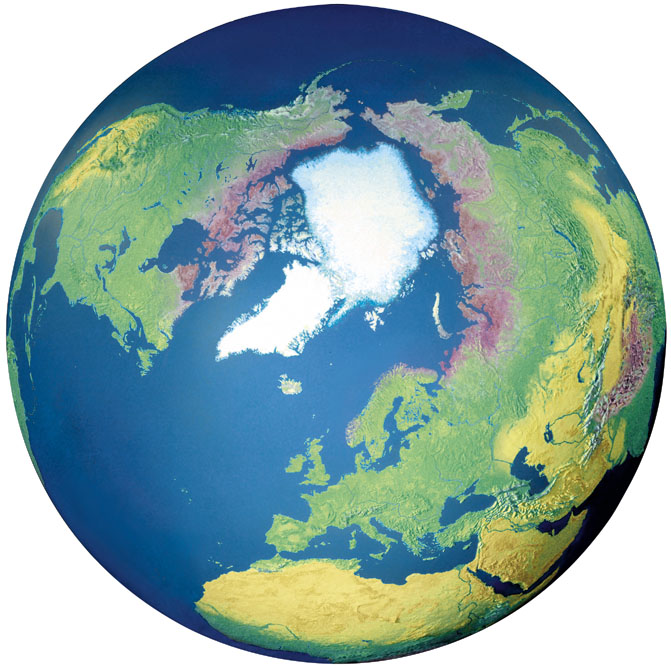
3) Keeping our irreplaceable homeworld blue, green, and white. To halt and eventually reverse environmental degradation or our homeworld, and underwrite economic well-being on a global basis, etc., by using lunar resources to provide ample clean energy on Earth on a sustainable basis. There are those who say we should tap asteroidal resources for this exclusively, on the grounds that the delta V needed to reach some of these objects is less than that needed to land on the Moon. That’s find for cargo. For human missions that dynamic reverses big time. Humans need life support: air, water, food. And missions to asteroids will involve much greater travel time than missions to the Moon, where in due time, there will be established biospheres from which these consumables can be replenished.
The Moon trumps with the triple advantage of “location, location, location.”
For building solar power satellites, asteroid materials can be accessed more cheaply but only on an irregular “target of opportunity” basis as launch windows to objects with low delta V access are the farther apart in time the lower the delta V. This is the catch-22 of orbital mechanics. The closer the orbital period of two bodies (Earth and a NEO) are, the less frequent the launch windows between them.
The Moon offers the option of direct hosting of lunar solar power arrays, adjacent to, or on the very regolith covered terrain from which the building materials to construct these arrays are to be found.
The Moon also boasts immense reserves of Helium-3, the ideal radiation-free fuel for fusion reactors, should we ever succeed in engineering them.
While asteroid resources can provide some haphazard irregular sourcing of materials for solar power satellites, the Moon can supply these on a continuous conveyor belt schedule, as well as alone support the other two clean energy options identified.
The upshot is that there is a logical human expansion “triway to space,” and that all three portions of this triway must be pursued.
1) We must defend the planet against catastrophic impacts.
2) In the meantime, we must guarantee the survival of our species no matter what by creating a viable self-sufficient colony on Mars.
3) And we must work to halt and then reverse human-caused degradation of our homeworld environment, as can best be done by taping lunar resources for bountiful clean energy.
If the Moon Society adopts this comprehensive strategy, more space enthusiasts will find us relevant, and a dynamic society deserving their support. This strategy will also be one with which we can attempt a rapprochement with the environmental community. For if they are honest, they must support it also.
Moon Miners’ Manifesto has long put out one Mars Theme special issue a year, at first on no special schedule, but for some time now, always the March issue. We have has asteroid issues, but they have been fewer, and farther in between. We’ll try to correct this.
As for the Moon Society, this strategy should guide us in forging new affiliations and working agreements with other organizations and efforts. But our prime focus, both of the newsletter and of the society, will remain on the Lunar Frontier, and its mission to help reverse the environmental collapse of our beautiful and irreplaceable home planet.
Space - what’s in it for the average Joe? Everything! Survival of our planet, restoration of our biosphere, a contingency exclave should disaster strike Earth despite our best efforts. To Earth!
Finding Collaborators
One of the most frequently heard criticisms of space enthusiasts is that “they cannot agree on goals.” I believe that the Triway to Space is a Roadmap that can earn majority support. But it won’t come easy.
The Space Frontier Foundation and the National Space Society will be the most open to this suggestion. While the Mars Society might seem a logical partner, there is one thing about the way government space programs are currently structured that makes the Moon appear a rival rather than a partner. The best use of hard to come by financial support is to apply government financing to the NEO project and to the exploration of Mars and the opening of the Mars Frontier. And ... to the further robotic exploration of the Moon. But government plans to field a permanent lunar outpost are the fly in the ointment. Budget cutbacks rooted in the enormous financial commitment to the war in Iraq make it almost certain that if a NASA outpost is fielded, it will be stillborn in terms of capacity to do anything useful, much less grow.
As long as a sizable fraction of lunar advocates are cheering on the NASA program for the Moon, the Mars people will see the Moon as a rival, not a collaborator. Mars Society spokesmen will continue to rip apart the NASA lunar program, and to deprecate the usefulness of the Moon to solving otherwise intractable environmental and energy plans on Earth.
Should the next administration be forced by inherited budget pressures to cancel the Lunar initiative, the Mars Society may find it easier to partner with the Moon Society, if the Society officially endorses the commercial route to Lunar Settlement, which, given its roots in the Artemis Project™ would certainly seem logical. It would then be much easier to bring the Mars Society into the Triway alliance.
I am not saying, mind you, that I agree with the Mars Society’s position. I don’t. While the goal of setting up a second human homeworld has very high value, working to save the one we have should take precedence. What seems imperative is to find ways to do both. Separation of funding sources would seem to be the logical first step in this direction.
We should support the Planetary Society’s modest efforts at detection of threatening NEOs and its project to design “tagging” systems to place transponders on especially dangerous asteroids so that we can follow them more easily. TPS, however, has no real use for manned space efforts, with the exception of manned exploration of Mars focused on the search for life.
Now it is not at all clear that the Planetary Society membership feels that way. But the hard reality is that TPS has been run as a theocracy from the outset. Members who disagree have no option other than choosing not to renew. But insofar as TPS projects are all eminently a good use of small funds, they deserve support. The upshot is that TPS will go its own way on this score, for the time being.
“Tit for tat” is a bankrupt policy, however. I recommend we support TPS (I am a long time member) even though they may remain aloof to our concerns.
Yet even a limited Moon Society-NSS-SFF “Triway Alliance” would command growing respect from the media, a respect that has a much better chance to turn recommendations into reality, winning us all many new members who sense we have our act together.
PK - address comments to kokhmmm@aol.com
Railroads on the Moon? Why not!

In a 1999 book (an updated edition is due in 2007) “The Moon: Resources, Future Development and Colonization” by David Schrunk, Burton Sharpe, Bonnie Cooper, and Madhu Thangavelu, the authors brought up the concept of a lunar railroad as a primary method of expanding out from the periphery of an innitial outpost towards a global lunar presence. The Amazon.com link below gives more details on the book itself.
http://www.amazon.com/gp/product/0471976350/sr=1-1/qid=1154725645/ref=sr_1_1/102-5936348-9380133?ie=UTF8&s=books
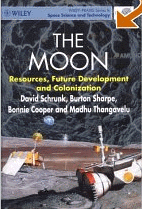
The idea was simply introduced, on pp. 93-95, with few details other than a suggestive illustration of a railroad erector, cargo, and power car, which would lay rail sections ahead of it.
Six years earlier, in July 1993, "Railroading on the Moon:A Define & Design Exercise,” the result of an email brainstorming effort of several contriutors, was first published in Moon Miners’ Review #13 and subsequently published online:
http://www.lunar-reclamation.org/papers/rr_moon.htm
In this paper, the authors took up several issues:
- Conventional or Maglev?
- The challenge of thermal expansion of rails
- The need for derailment proof systems
- Concept of the "Train", several cars linked together
- Locomotive Power Options
The following illustrations from this paper will serve as a teaser:
Competing maglev schemes
Shading the rails: three of many options
Anti-derailment options:
Anti_derailment options: center box
Anti-derailment systems: lowered center of gravity
In an upcoming issue of Moon Miners’ Manifesto (April or May 2007?) we will take up this topic again, in an effort to go beyond the two previous papers and to identify issues not previously taken up.
Peter Kokh
RAMADAS: “Yard” and Work site Canopies for Lunar Outposts
Link: http://www.moonsociety.org/2003-pcsn/20-ramadas.html
[Ra•ma•da (Ra MAH da) - a Spanish word common throughout U.S. treeless plains and desert areas for the shade-providing shelters at roadside rest stops.]
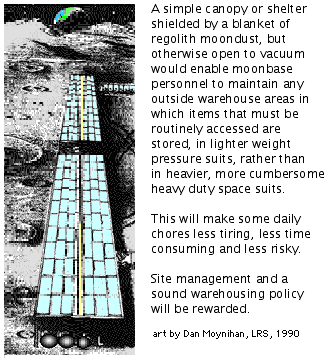
The sketches available of various Moon Base designs, be they the product of NASA think tanks or of outside sources, share an ivory tower penchant for neglecting patterns of likely land use in the immediate vicinity, in the front and back "yards" of principal base structures.
It is inevitable in any Lunar Base operations scenario, that an appreciable portion of routine "out-vac" EVA activity will take place in a few concentrated areas, especially the immediate vicinity of the Base itself, and of its component structures and facilities. There should be a very thorough effort to identify and categorize the types of activities involved and the intensity of use of these "yard" spaces.
Current planning and design provisions make no distinction between those EVA activities on the base doorstep and those spacesuits-required activities at some distance from camp. However, the relatively high intensity of usage of selected close-in areas for storage, staging, repairs, or other repetitive outdoors housekeeping tasks, offers us an opportunity to make such routine activities both safer and easier.
Reducing the risks to personnel by reducing the accumulative need for hours of EVA has been a principle driver for ISS design, however. So one might expect that this proposal*, made in the July 1990 MMM #37 issue would have NASA’s attention. [* republished in MMM Classic #4]
http://www.moonsociety.org/publications/mmm_classics
By designing lightweight, modular, and easily deployable work canopies or "ramadas" strong enough to hold a radiation absorbing blanket* of regolith insulation blown on top, Lunar Base architects can provide built-in cosmic ray, ultraviolet, and micrometeorite protection for these high use activity areas. Providing ramadas will allow those working in such sheltered areas, while still exposed to vacuum, to wear lightweight more comfortable pressure suits. Under such improved conditions, those working outdoors could put in more hours with significantly less fatigue, with lessened vulnerability to random micrometeorites, and with reduced cumulative radiation exposure.
* [the weight per square meter of 2 meters overlay of regolith with a specific gravity of 2.8 g/c3 in 1/6th g is ab out 933k (nearly one metric ton) or 2053 lb. This equates to about 190 lbs/sf]
Under these structures, we could store:
• tanks of scavenged solar wind volatiles, fuels, LOX, etc.
• containers of black water (toilet waste solids) awaiting treatment
• raw materials sorted or beneficiated by on site processing
• products made locally, awaiting domestic use or export
• external utilities & power & power storage systems
• other equipment that must be serviced regularly
• a garage for vehicle maintenance
Not only does such a canopy or ramada make for better and safer working conditions, it provides a thermally stable environment where materials that could be adversely affected by incessant cycling of dayspan heat and nightspan cold can be stored indefinitely. Materials stored there would also be sheltered from the micrometeorite rain.
Such ramadas might be attached to various base structures themselves, in an analogy to awnings and lean-to sheds, or stand free but adjacent to them. They could cover an area continuously or make use of overlapping panels to allow some reflected sunlight to ricochet between top and bottom surfaces into the working spaces below.
Those whose assignments take them beyond such protected yard areas will still require the heavier more cumbersome hardsuits. For some such cases it may be possible to design mobile or "redeployable" ramadas to use at temporary sites of heavy outdoor activity such as can be expected in the field at prospecting sites or with the time-consuming installation of scientific equipment, solar arrays etc.
How could such shelters be constructed? The parts for an initial shelter would have to be brought from Earth. A space frame can be shipped in compact, folded form - we have already done similar things in deploying the International Space Station. It could be covered with a light weight fabric, able to hold the weight load of a foot of sand on Earth - a close approximation to the weight of 2 meters of moondust on the Moon
In time, we should be able to make the equivalent locally, fashioning space frame spars and struts from glass-glass composites. As for a fabric covering, that will be a bit more of a challenge, though layers of fiberglass mesh, topped with a thin fiberglass felt may work.
As Lunar manufacturing develops, the materials, all manufactured on site, could fairly early on become the standard means of providing safe workspaces sheltered from the avoidable "elements" that buffet the exposed Lunar surface. And no doubt, these early products would find many other uses and applications.
As an incentive for early development of the capacity to locally manufacture the components of such shelter systems, NASA might consider the benefits of simply parking the main outpost habitat modules underneath such a shelter, in lieu of shielding them directly, either with plain moondust, or with removable bags or blocks of moondust. Access to the hulls of the various modules would then be a simple matter. But an ever greater advantage would be the ease with which the layout of the various modules could be altered. New modules could be placed where their intended use makes most sense, instead of at one “end” or the “other.” The shelter itself could be easily designed to be expandable.

Without a well thought out warehousing and site management policy, we will end up with an unsightly clutter on the order of the mess exposed to the world by Greenpeace at McMurdo Sound in Antarctica. While a strategy of careful management of high-use yard space, including the use of ramadas, would prevent such unsightly disorder, that is certainly not its principal merit. Disorderly storage would be a symptom of the deeper ill of lackadaisical management of base operations. That same carelessness spawns accidents, both mechanical and human.
Most will accept that we cannot tolerate the expense of mismanagement on the Moon. Part of good base management will consist in providing the safest possible routine working conditions. The added cost of bringing along the materials to erect ramadas over those highest-use outdoor areas around the base will be well justified.
Regardless of what NASA does or does not do, we can model this feature in any future Moon Society-NSS Lunar Analog Research Station.
Next time you see an artist's depiction of a Moon Base, whether it comes from NASA, the Lunar & Planetary Institute, SSI or Eagle Engineering, or wherever else, ask yourself "what's wrong with this picture?" If the grounds look neat and uncluttered all without ramada shelters, the rendering will clearly be more akin to science fantasy than science fact. It is hard to interpret such illustrations as anything other than efforts at self-delusion.
If ramadas are essential facilities for Lunar bases, no matter how absent from base concepts currently in vogue, then a national competition to come up with some good design options would be in order. Such a competition should have three categories:
(1) for first generation bases, the most economical use of imported material; per square meter sheltered;
(2) for next generation bases, early practical use of building-materials made on site; and
(3) for mobile and/or redeployable ramadas to be used in the field.
Prize money to entice participation could come from traditional sources such as aerospace contractors, but also from materials industries who wanted to promote the use of their products.
[This article is an expansion of an abstract sent to AIAA in 1990 in response to its solicitation of ideas for Moon/Mars Missions & Bases. [Thanks to Michael J. Mackowski, then of St. Louis Space Frontier Society, for alerting MMM to this opportunity.]
[Artwork by Dan Moynihan]
Peter Kokh
Analog Moonbase Proposal Slide Show
December 10, 2006
Download our PowerPoint Slide Show version 1.02
http://www.moonsociety.org/moonbasesim/proposals/AnalogMoonbaseProposal.ppt
For those who do not have PowerPoint, you can download the PDF file version of this Slide Show
http://www.moonsociety.org/moonbasesim/proposals/AnalogMoonbaseProposal.pdf
Earlier this year, a Moon Society Crew "took over" the Mars Desert research Station outside Hanksville, Utah for two weeks, hoisted our flag, and got our feet wet conducting a number of projects. The idea was to gain experience about what an analog station research program might become in a Moon Society context.

We have been gathering ideas for some time about how the Moon Society, in a possible collaboration with the National Space Society, could phase in a Lunar Analog Research Station Facility.
We’ve attempted to define our research goals, and they turn out to be quite different than those of the Mars Society’s justly famous stations in the Canadian Arctic ad in Utah.
http://www.moonsociety.org/blog/index.php?title=lunar_analog_outpost_news_10_29_06&more=1&c=1&tb=1&pb
We’ve developed a short list of potential sites. basaltic lava flow areas with on site or nearby lavatubes
We’ve been following with great interest the “Mobile-Modular” architecture being pursued by the Calgary Space Workers (web reference just above) for its many advantages: modules can be outfitted where a cluster of volunteers live, saving a lot of money on logistics.
But meanwhile, we have been looking for ways to model a non-mobile modular-unit with integrated modular biosphere. The Mars Society paid $200,000 for the fabrication of the unit in the Arctic, half that for the Hab in Utah. These sums do not include the money spent on utility systems and interior outfitting, shipping to the site, etc.
The modular approach allows a deployment in Phases, a module or two at a time. Can we find a ready made structure that can be adapted for service as an analog station module?
This proposal as based on one such option, but includes details of the Research Program it would support, as well as on the Outreach Program that could be developed as the Outpost grew, phase by phase.
The goal of this effort is to develop a detailed plan, a blueprint for a phased in extensive analog outpost operation, a document that will be ready to present to potential funders. That it can be broken down into individual components, each of which can be funded separately, gives us an enormous advantage, and greatly lowers the threshold for breaking ground on Phase I.
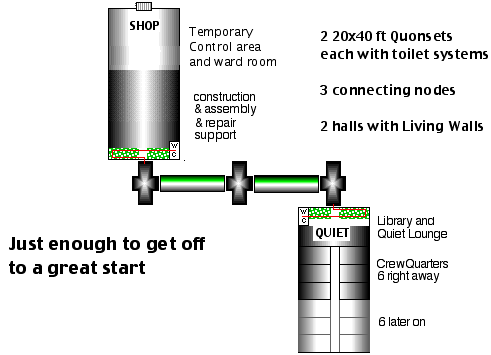
There is a lot of homework yet to be done.
We have a lot of work to do before we can identify, and secure the rights to, a final ideal location.
Many things can be done in greater or less detail, with greater or less fidelity to what would be realistic on the Moon. We need to compare options, identify cost-benefits for each, and, as money IS an issue, pick our “battles” with care.
Whichever available module core structure we pick, we will have to develop definitive plans for insulation, utilities, interior walls, flooring, doorways, connections to other modules, etc.
We want to treat our black water toilet wastes and there are a number of systems to look at: the Wolverton system probably the foremost. The MDRS project had nothing but trouble with the original Incinolet.
We want to incorporate other biospheric systems as well, and here too, the details need to be worked out.
How do we do connecting hallways, nodes, airlocks? The MDRS airlock system could be adapted, with some modifications
We need to do more compete and accurate costing
The logistics issues of outfitting modules on location, in contrast to where clusters of volunteers are available all the time, must be addressed
We will need an engineering/utilities team, and a construction/outfitting team
design contests will help develop some of the options as well as spark interest. But we cannot announce them until we have defined the needed constraints which may include dimensions, usage, materials, and other parameters
Meanwhile, we will continue to look at entirely different alternatives. Our philosophy must be to push all the options until it becomes quite clear which will be most advantageous. Economy, Logistics, and Human Resources are all relevant.
Your comments and feedback our welcome.
Peter Kokh
president@moonsociety.org
Usefulness of Terrestrial Lavatubes in a Lunar Analog Research Station Program
Link: http://www.moonsociety.org/2003-pcsn/19-lavatubes.html
As promising as lunar lavatubes are for the future of lunar settlements, in the early days of the frontier, it is more likely that the main settlement complex will be on the surface, covered with a regolith blanket, and that a nearby lavatube will be used for area-hungry unpressurized applications such as warehousing and storage, tank farms, and even industrial parks. Sealing and pressurizing a cave is a daunting task that may not be attempted for some time.
Lavatubes on Earth are much smaller in scale than those on the Moon, probably in some inverse relationship to gravity. Typical widths are on the order of 20-80 ft, but tubes towards the narrower part of that range are more common.
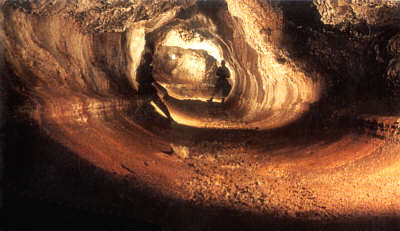
A lavatube in the Azores
Because of their much smaller scale, they are hardly simulation stand-ins for those on the Moon. But we can put them to some use.
In August 1992, I had the wonderful experience of a personal guided tour of the pair of lava tube caves outside Bend, Oregon that the Oregon L5 Society was using for outpost simulation purposes. My guides were Bryce Walden and Cheryl Lynn York of Oregon L5. The photo below shows Cheryl York standing in such an entrance at the Oregon Moonbase site.
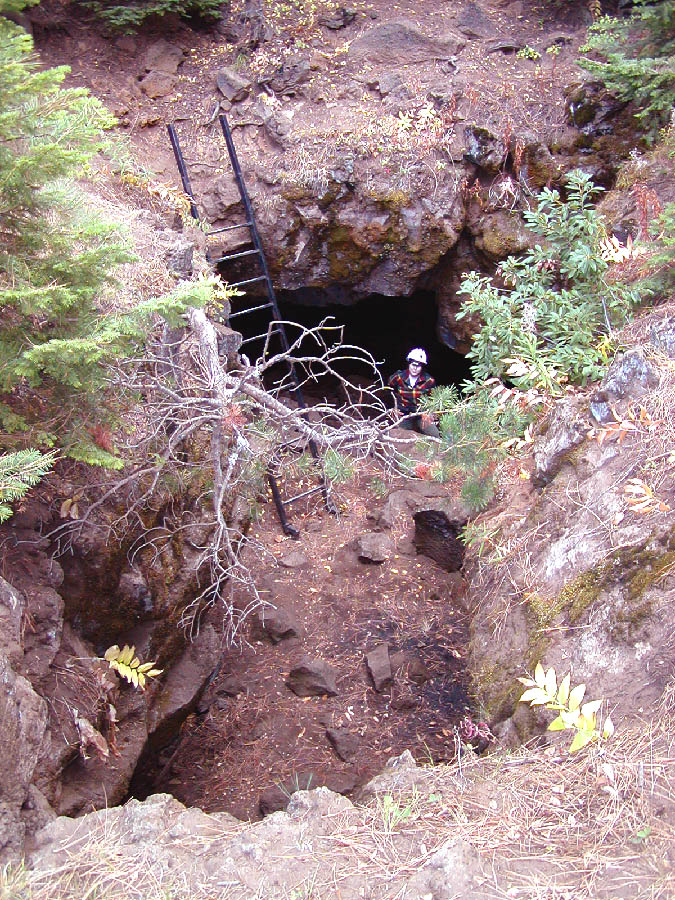
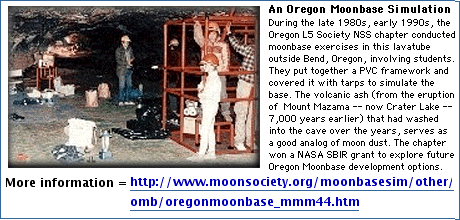
Oregon Moonbase Photo taken during a simulation. The PVC tube frame would be covered with a tarp to serve as a makeshift base for students. The cave floor is flat due to the invasion of volcanic ash from the explosive eruption of Mt. Mazama 4,800 BC that formed the jewel known as Crater Lake, 85 miles to the WSW of Bend.
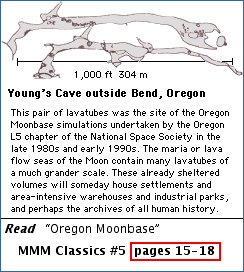
Above: Young’s Cave complex outside Bend, OR.
They put this lavatube complex to work. The mission tested organization, design, logistics, construction, human factors, and educational opportunities. Included were both a surface camp and a ‘lunar base’ inside the cave. The in-tube base consisted of a sleep/work platform, a communications desk, a galley, and a sanitation facility. Mission science included cave mapping, astronomy, geochemistry, and environmental monitoring.
And on July 20, 1989, NASA granted the Oregon chapter $25,000 to do a thorough site characterization.
The Geological survey was done by Stephen L. Gillett, a consulting geologist now in Carson City, Nevada with U-NV-Reno.
Century West Engineering of Bend did the engineering analysis. A series of 5 borings, in roomy locations specified by Oregon L5, showed the roof to be generally from 10 to 20 feet thick with 7-19 ft of hard basalt overlain by 0-3 ft of loose soil. Except for a few transverse cooling cracks, the ceiling is relatively intact and rock quality analysis shows the roof could support from 2-60 tons suspended weight per linear foot, depending on varying roof thickness and the presence presence or absence of fractures. For this, a system of rock bolts will do. In weak areas, roof-shoring supports are advised. Some 6000-7500 cubic yards of sand forms a floor 0-6 ft thick. This could be removed, if desired, by vacuuming. Rock debris could also be removed, if desired, by backhoe or by hoists through openings made in the roof, thereafter available for installation of equipment. But creating such openings whether by blasting, jackhammer, or rocksaw would be a major undertaking. The variations of surface terrain was also surveyed.
The estimated cost of preparing the site as a major lunar analog facility as outlined by the Oregon Moonbase team was over $6 million 1990 dollars. The Phase II grant never came. Eventually, the chapter decided to let the renewable 5-year lease on the facility expire.
But on the basis of what we learned about this pair of lavatubes during the study, we think that this facility, if we could regain access, or a similar tube elsewhere, could support unique simulation exercises. If the main moonbase facility was up on the surface nearby and only limited simulations done in the lavatube “outpost annex”, the cost could be significantly lower, with a very modest initial presence expanded on a pay-as-you-go expansion basis.
The five 60 mm (2 3/8”) bore holes through the tube roof-ceiling, typically through 8-20 feet of overlying soil and basaltic rock, could be used to drop in miniaturized survey equipment designed to demonstrate how we can robotically map the interior of lunar lava tubes in 3 dimensions, profiling their complex shapes and cross-sections.
Someday, lunar lavatubes could be mapped robotically in this fashion, without putting human exo-spelunkers at risk. Those tubes with the most promise for future utilization would then be candidates for further human exploration.
These mapping demonstration tests finished, the bore holes could be filled with fiber optic bundles to let in sunlight pre-concentrated up to thirty times.

Letting the Sunlight in down under
Additional bore holes could be used for communications cable access, electric power supply entrance, fresh water supply, etcetera.
What the Oregon L5 Moonbase Team did, provides a model to follow. A small Habitat complex could be put together out of small inflatable units or of EZ assemble-disassemble semi-prefab structures. At such a facility, where, within the lavatube, lighting would be totally controllable, we could more easily simulate the lunar dayspan/nightspan cycle. We could examine ways of dealing with the two week long nightspan that would let a crew remain productive throughout. We would try to determine how little power we could get by on and still be productive, concentrating on repairs, maintenance, inventory, and other power-light, manpower-intensive tasks, so as to better use the 15 days of dayspan solar power available to store up power to tap after lunar sundown.
Meanwhile, a nearby surface conventional outpost complex would investigate and demonstrate other things: teleoperations; in situ resource utilization; shielding options; and many more lines of investigation. While it would be ideal for the companion analog surface outpost to be very close to the lavatube entrance, a separation of a few miles should not hinder operations. Crew would go from one to the other in a “pressurized vehicle.” This allows room for latitude if it is not possible to have both outpost components closely collocated.
If the access to the Bend, Oregon site can’t be recovered, we might do something similar at lavatube locations at Craters of the Moon National Park, ID; El Mapais National Monument, NM; or Snow Canyon State Park, UT. The advantage of Bend is that the lavatube complex there is well known and studied, and familiar to a number of Moon Society members. At both Bend and at the Mars desert Research Station outside Hanksville, Utah, the landowner is the U.S. Bureau of Land Management through which a free lease can be had under conditions that the site can be returned to its natural state if and when no longer needed. Private land, leased at no cost, is an option as well, but one not so easily arranged.
A Lavatube outpost annex allows the advantage of year-around operation, even in seasonal periods in which the surface outpost may be unbearable or problem-wracked. Underground temperatures stay the same year around.
Further Reading:
What Do Lavatubes Look Like?
http://www.lunar-reclamation.org/papers/lavatube_pix.htm
The Potential of Lunar Lavatubes
http://www.lunar-reclamation.org/papers/lavatubes_ccc.htm
Oregon Moonbase links
http://www.moonsociety.org/moonbasesim/moonbase_analogs_net.html#omb
Peter Kokh
 02/07/07 08:49:45 pm,
02/07/07 08:49:45 pm,